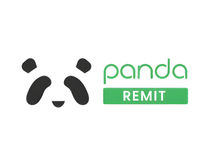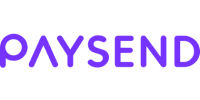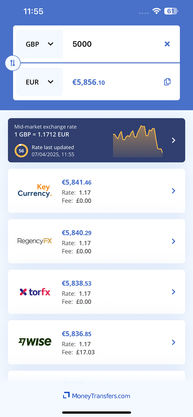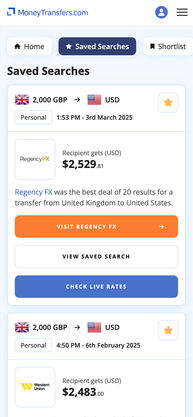Find the best ways to transfer money to Indonesia
Compare money transfer deals for sending IDR.
Find the best, cheapest, and easiest ways to send money to Indonesia at the best IDR exchange rates.
Read on for the best deals, expert information, and all you need to transfer money to Indonesia.
Send money to Indonesia
"Over 16 million customers use Wise, mostly for their excellent mobile app, transparent fee structure & use of mid-market rates. Now increasingly used for larger transfers."
"Over 16 million customers use Wise, mostly for their excellent mobile app, transparent fee structure & use of mid-market rates. Now increasingly used for larger transfers."
"Over 16 million customers use Wise, mostly for their excellent mobile app, transparent fee structure & use of mid-market rates. Now increasingly used for larger transfers."
"Xe has over 30 years of currency exchange experience, and is one of the most reputable names on the market. 200 countries, 100 currencies, & funds often received in seconds."
"Xe has over 30 years of currency exchange experience, and is one of the most reputable names on the market. 200 countries, 100 currencies, & funds often received in seconds."
"Xe has over 30 years of currency exchange experience, and is one of the most reputable names on the market. 200 countries, 100 currencies, & funds often received in seconds."
"Over 16 million customers use Wise, mostly for their excellent mobile app, transparent fee structure & use of mid-market rates. Now increasingly used for larger transfers."
"Over 16 million customers use Wise, mostly for their excellent mobile app, transparent fee structure & use of mid-market rates. Now increasingly used for larger transfers."
"Over 16 million customers use Wise, mostly for their excellent mobile app, transparent fee structure & use of mid-market rates. Now increasingly used for larger transfers."
"Revolut has 50+ million customers globally. You can hold up to 36 currencies in the app and send money quickly in 70+ currencies to 160+ countries."
"Revolut has 50+ million customers globally. You can hold up to 36 currencies in the app and send money quickly in 70+ currencies to 160+ countries."
"Revolut has 50+ million customers globally. You can hold up to 36 currencies in the app and send money quickly in 70+ currencies to 160+ countries."
"24/7 live chat support provided in six languages. Special first transfer rates available, with airtime topup supported to many countries in Africa, Asia and South America."
"24/7 live chat support provided in six languages. Special first transfer rates available, with airtime topup supported to many countries in Africa, Asia and South America."
"24/7 live chat support provided in six languages. Special first transfer rates available, with airtime topup supported to many countries in Africa, Asia and South America."
"Xe has over 30 years of currency exchange experience, and is one of the most reputable names on the market. 200 countries, 100 currencies, & funds often received in seconds."
"Xe has over 30 years of currency exchange experience, and is one of the most reputable names on the market. 200 countries, 100 currencies, & funds often received in seconds."
"Xe has over 30 years of currency exchange experience, and is one of the most reputable names on the market. 200 countries, 100 currencies, & funds often received in seconds."
"OFX have been helping individuals and businesses send money for over 25 years. Transfer in 50+ currencies to 170+ countries, with 24/7 phone access to currency experts."
"OFX have been helping individuals and businesses send money for over 25 years. Transfer in 50+ currencies to 170+ countries, with 24/7 phone access to currency experts."
"OFX have been helping individuals and businesses send money for over 25 years. Transfer in 50+ currencies to 170+ countries, with 24/7 phone access to currency experts."
"Remitly focuses on sending money to friends and family in Asia, Africa and South America. Wide coverage and well-suited to regular transfers home."
"Remitly focuses on sending money to friends and family in Asia, Africa and South America. Wide coverage and well-suited to regular transfers home."
"Remitly focuses on sending money to friends and family in Asia, Africa and South America. Wide coverage and well-suited to regular transfers home."
"Xoom, a PayPal service, allows you to send money in more than 160 countries. You can send cash for over-the-counter pickup or home delivery, as well as send by bank transfer or debit card."
"Xoom, a PayPal service, allows you to send money in more than 160 countries. You can send cash for over-the-counter pickup or home delivery, as well as send by bank transfer or debit card."
"Xoom, a PayPal service, allows you to send money in more than 160 countries. You can send cash for over-the-counter pickup or home delivery, as well as send by bank transfer or debit card."
"Securely send money to and from 150+ countries and 20+ currencies. Same-day transfers avaialble on most major currencies."
"Securely send money to and from 150+ countries and 20+ currencies. Same-day transfers avaialble on most major currencies."
"Securely send money to and from 150+ countries and 20+ currencies. Same-day transfers avaialble on most major currencies."
"Sendwave is trusted by over 1 million users across the US, UK, Canada and EU. 24/7 support is available online and via the app."
"Sendwave is trusted by over 1 million users across the US, UK, Canada and EU. 24/7 support is available online and via the app."
"Sendwave is trusted by over 1 million users across the US, UK, Canada and EU. 24/7 support is available online and via the app."
"Send money to over 40 destinations online and in the mobile app."
"Send money to over 40 destinations online and in the mobile app."
"Send money to over 40 destinations online and in the mobile app."
"Paysend has transparent fees and rates, with transfer sent within seconds to your recipient's bank. They also have global 24/7 support for any enquiries, and bank-level security."
"Paysend has transparent fees and rates, with transfer sent within seconds to your recipient's bank. They also have global 24/7 support for any enquiries, and bank-level security."
"Paysend has transparent fees and rates, with transfer sent within seconds to your recipient's bank. They also have global 24/7 support for any enquiries, and bank-level security."
"Moneygram is a well established service with over 80 years in the sector. They support over 200 countries worldwide and have over 440,000 retail locations."
"Moneygram is a well established service with over 80 years in the sector. They support over 200 countries worldwide and have over 440,000 retail locations."
"Moneygram is a well established service with over 80 years in the sector. They support over 200 countries worldwide and have over 440,000 retail locations."
How to send money to Indonesia with the best rate
Always compare rates
Don't pay more than you have to. Use our live comparison tool to make sure you aren't missing the best rates when sending money to Indonesia.
Choose a provider
Select the provider that offers you the most IDR and fits your needs.
Click, sign up & send
Follow the steps & make your transfer. Your funds will soon be on their way to your chosen country & currency.
Overall best choice: Wise
We tested & reviewed 12 companies offering transfers to Indonesia, and Wise scored the highest.
Wise offers the best combination of transfer fees, rates, speed, and has the best overall experience for transfers to Indonesia.
At the moment, if you were to send $7,000 to IDR, it would cost you $39.41 in fees, and your recipient will get 116,088,720 IDR.
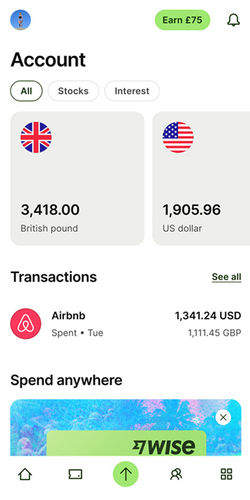
The cheapest way to send money to Indonesia: Panda Remit
From the 12 companies tested, Panda Remit consistently offers the cheapest money transfer IDR to Indonesia.
Panda Remit charges $4 per transfer to Indonesia and applies a 0.3% markup on the IDR exchange rate.
For the best value, use a bank transfer deposit to maximize the amount of IDR received.
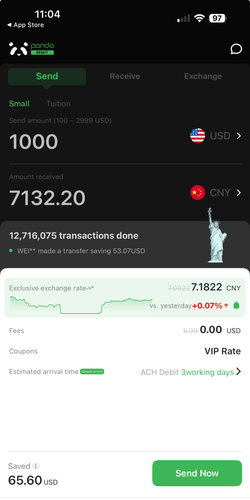
The fastest way to send money to Indonesia: Panda Remit
Based on a $7,000 transfer and our comparison data for IDR transfers, Panda Remit is the quickest option for sending IDR to Indonesia.
With Panda Remit, the transfer time to Indonesia is minutes - 24 hours.
They charge $4 in fees and apply a 0.3% markup on the ‘real’ IDR rate. This is 0% cheaper than the second-best provider.
For the best balance between speed and cost, we suggest using a deposit for Rupiah transfers.

The easiest way to send money to Indonesia: Wise
They offer transparent fees, charging $39.41 per transfer with 0.1% markup added to the IDR rate.
Getting started with Wise takes less than 3 minutes, making it a fast, affordable, and user-friendly choice for sending Rupiahs.

Consider this before sending money to Indonesia
Don't settle for the first option. Always compare ways to send money to Indonesia to find out about fees, speed, and reliability.
Our analysis included 12 providers that operate in Indonesia.
Through this, you get a comprehensive view of all the options you have when sending money to Indonesia.
Making large money transfers to Indonesia
When sending large amounts of Rupiah to Indonesia, it's important to consider factors like the limits, IDR rates, customer support, as well as legal and government-imposed restrictions in Indonesia.
Wise is our top recommendation for moving large amounts of IDR.
Whether you're purchasing property in Indonesia, need to pay tuition fees, have a wedding there, or transfer money for business in Indonesia, Wise will ensure a smooth and secure transaction.
Of all the companies we’ve tested and reviewed that specialize in large IDR transfers, Wise consistently ranked as the top-rated choice.
They charge $39.41 per transfer and apply 0.1% markup on top of the IDR exchange rate, making them perfect for moving big amounts.

Understand the costs of money transfers to Indonesia
The total cost of IDR transfers depends on your location, the amount of IDR sent, the delivery/deposit methods, transfer fees, and the markup applied to the IDR exchange rate.
Transfer fee
The money transfer service you use to send Rupiah can apply a fixed fee, a percentage-based fee, or a combination of both.
For example, a $7,000 transfer to Indonesia will cost you $0 in fees with OFX, based on our January 2026 analysis of 12 services supporting Rupiah transfers.
IDR exchange rate markup
An exchange rate markup is the percentage added to the mid-market IDR rate.
Using the same example, Wise offers the best IDR exchange rates, with a 0.1% markup on the USD-IDR rate. This means for every USD sent, you receive 16,694 IDR with 0.1% deducted from it.
Deposit method
How you fund your transfer can significantly impact the overall cost.
Bank transfer is the most common option, costing up to $490 per transfer to Indonesia.
Debit card transfers can go as high as $0 in fees, while credit cards are usually more expensive and may include additional cash advance fees.
bank transfer is the cheapest payment method for sending IDR.

How to find the best exchange rate for Rupiah transfers
An exchange rate is a constantly changing value of IDR in relation to another currency. The exchange rate you secure impacts how much IDR you will get, so timing your transfer is essential to get the most out of it.
Let's dive into some recent IDR trends.
Over the past week, the exchange rate from USD to IDR has seen some fluctuation. On average, it stood at 16,747.3929 Rupiah.
During this period, the highest value recorded for Rupiah was 16,781.5, while the lowest was 16,694.
Wise, which is our recommended service for sending money online to Indonesia offers an exchange rate that is only 0.1% above the mid-market rate.
Want to secure the best Rupiah exchange rates?
Sign up for our rate alerts and we'll tell you when it's the best time to move your money to Indonesia!
Top payment methods to use for transfers to Indonesia
Money transfer companies will offer different ways to fund your transfer to Indonesia. Depending on the service used, deposit options can affect the speed, the cost of your transfer, and the amount of IDR received.
Bank transfers
Bank transfers are a standard deposit method used for sending money to Indonesia. Almost all services covering Indonesia offer it.
Bank transfers to Indonesia are usually cheaper than other deposit methods but can take up to 3 business days for IDR to reach Indonesia.
Out of 12 providers we’ve tested, we found Panda Remit to be the cheapest for bank deposits, with just $4 per transfer and a 0.3% markup. This is 0.14% cheaper than the second-best option.
When possible, avoid using wire transfers over the SWIFT network for IDR transfers. It is slower and more expensive due to intermediaries involved, instead, look for an ACH deposit option.

Debit and prepaid cards
Debit card transfers to ID are usually faster than bank transfers.
Most IDR transfers can take up to a few hours but it can be slightly more expensive.
We recommend using Xe if you want to use a debit card or prepaid card to fund your money transfer to Indonesia.
With Xe, you can expect to pay $0 in fees and 0.66% markup when depositing money with a debit card. This is 0.76% cheaper than using the next best provider out of the 12 companies supporting IDR transfers we’ve tested.

Credit cards
You can also use a credit card to fund your transfer to Indonesia.
We found a few options for credit card transfers out of 12 companies compared.
Credit card deposits are usually more expensive when sending money to Indonesia, so if you can, use a bank transfer or debit card deposits so save on fees.
If you do need to make a CC deposit, we recommend running a .
Cash advance alert
Your credit card company may charge you a cash advance fee and offer higher interest rates for international transactions to ID. We recommend avoiding credit cards, and instead opt for a bank or debit card transfer.

How we analyze the market
We track the cost, speed, and product offerings of the leading money transfer services available in Indonesia.
Our comparison engine and algorithms evaluate providers based on over 25 factors, including transfer fees, ease of use, exchange rates, mobile apps, transfer times & customer support.
We also consider how these services are rated on platforms like TrustPilot, AppStore, and Google Play, giving you a comprehensive view of what to expect.
This thorough analysis helps you get the best available deal - every time you want to move money to Indonesia.
We also provide unbiased and detailed reviews of all the top money transfer companies. You can use these reviews to find the best service for your needs when sending money to Indonesia
For a deeper understanding of our commitment to integrity and transparency, we invite you to read our editorial policy and review methodology.

Related transfer routes
Send money from Indonesia
Send money to Indonesia
FAQs
Find answers to the most common questions on our dedicated FAQ page.
How much money can be transferred to Indonesia?
Are there any tax implications to sending money to Indonesia?
What are the typical transfer fees for sending money to Indonesia?
How long does it take for IDR to reach Indonesia?
Are there any min/max limits on IDR transfers?
Can I schedule regular payments to Indonesia?
What currency is used in Indonesia?
Can I send IDR from any country?
How can I track my money transfer to Indonesia?
What should I do if my money transfer to Indonesia goes wrong?
Can’t I use my bank to transfer money to Indonesia?
Can I send IDR with MoneyTransfers.com?
Tools & resources
Contributors










